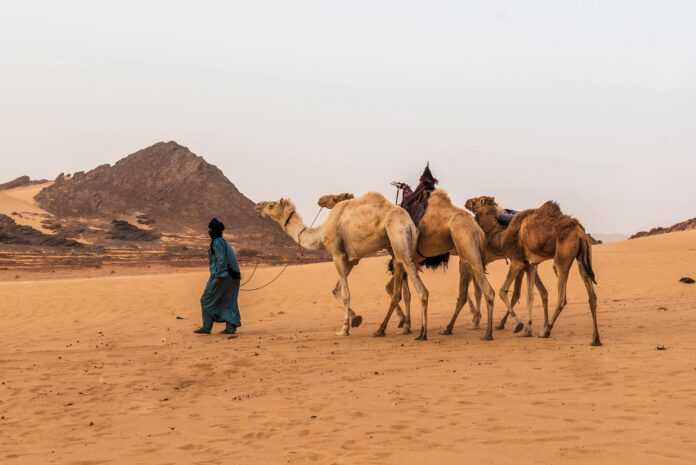
The legacy of colonialism and the departure from traditional pastoral practices has had profound ecological consequences on the desert biome—geographical areas defined by their vegetation, soil types, climate, and animal species. Deserts have been the sites of historical extractivism which have accelerated desertification, polluted local water sources, and caused irreversible environmental damage. Deserts have been undergoing significant transformation and expansion due to the lack of conservation efforts, and this can be linked to how many have viewed the desert as barren or empty. The ongoing climate crisis has led to it being an overlooked biome despite its vulnerability and on the brink of ecological collapse.
From nuclear testing in the Sahara by the French to the desert used as a tool for the displacement of the Nubian people, the ecological impact of colonial powers on deserts around the world has been profound and destructive. According to Dr. Samia Henni, the desert and those who inhabit it have been systematically racialized and marginalized, enduring ongoing violence and exploitation driven by colonial ideologies that seek to dominate and reshape these landscapes. This highlights the vulnerability and importance of deserts and the people who inhabit them globally.
Read More: 10 Must-Reads on Climate, Environment & Islam
Deserts are arid biomes, characterized by the lack of precipitation, typically receiving less than 10 inches of rain per year and make up one-third of our planet’s land surface. Examples include the Sahara in Africa, the Mojave Desert in North America, and the Gobi Desert in Asia. Deserts are also defined by their sparse vegetation, specialized fauna, unique soil characteristics, and water scarcity. The arid desert biome is crucial for global climate regulation and carbon cycling. Through the carbon cycle, carbon atoms repeatedly move between the atmosphere and Earth’s organisms, primarily stored in rocks, sediments, oceans, atmosphere, and living beings, facilitating continuous reuse. Deserts can act as “carbon sinks”, storing carbon by accumulating organic matter in their soil and experiencing slow decomposition rates, although this depends on many other factors.
Deserts are a significant source of natural mineral aerosols, tiny particles suspended in the air that play a crucial role in atmospheric dynamics, climate processes, and ecosystem functions. They can be of either natural origin or man-made origin. Anthropogenic aerosols result from human activities such as industrial processes, transportation emissions, and agricultural activities while natural aerosols originate from sources such as sea spray, dust storms, and volcanic ash. Mineral aerosols are one of the most important atmospheric aerosols, and the majority are from the Sahara and Sahel region impacting hurricane formation in the Atlantic and fertilizing the Amazon Basin.
The Many Ways of Seeing the Desert
In John Berger’s seminal text and BBC program Ways of Seeing, the British art critic examines the mechanics of perception, exploring how viewers engage with art. This parallels the need for critical examination when observing our planet. It requires us to scrutinize the lenses through which we understand and describe the natural world. When advocating for environmental justice, it becomes essential to critically examine how colonialism has shaped our perceptions and descriptions of the natural world. Similarly, in the group exhibition Getting Over the Color Green, artists discussed the impact green has had on their perceptions of the world and surroundings despite being in a naturally arid region. Curators Athoub AlBusaily and Gaith Abdulla posed questions in their open call for art submissions, addressing how to dismantle the associations of arid landscapes with colonial ideologies.
Read More: What is Climate Colonialism?
Colonial powers have viewed deserts as barren and desolate, often considering them as ‘unwanted’ regions despite their exploitation. However, Deserts have served as conduits of knowledge and points of transaction and trade, with the deserts of the Hijaz being the birthplace of Islam as we know it today. In Deserts Are Not Empty (2022), Danika Cooper argues that emptiness is neither a geographical category nor an ecological feature. Unfortunately, this perception of the desert as empty extends not only to its cartographic depiction but also to the flora, fauna, and people that inhabit it. When advocating for environmental justice, it becomes essential to critically examine how colonialism has shaped our perceptions and descriptions of the natural world. For example, the phrase “making the desert bloom” has been used to legitimize settler colonialism, often serving as a form of greenwashing, while implying the necessity of “filing” it through occupation. This has had a profound impact on how many view the environment.
A Holistic Understanding of Planet Earth
To the untrained eye, the desert landscape evokes a sense of alienation. To the colonial gaze, it is to be conquered, a testing ground, and a site for dissent. However, for those who belong to deserts, it is a site of memories and heritage. Divorcing the desert from “barren” and “obsolete” requires a transformative shift in perspective. Although the desert is ecologically fragile, it plays a major role in maintaining our planet. To be stewards of Earth, we must embrace its different states of being. From the fiery eruptions of volcanoes to the mysterious depths of the oceans, to the vast expanses of arid deserts—these all contribute to the unique identity of our planet.
Viewing Earth solely through a lens of greenery overlooks its complexity, much like the layers of the atmosphere, each with its role. It’s a humbling realization that nature encompasses all aspects of existence, and as inhabitants of this planet, we are inherently intertwined with it.


